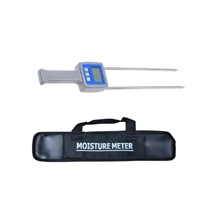Moisture meter, also called moisture meter, moisture detector, moisture meter, moisture analyzer, moisture content detector, water meter, etc., refers to the ability to detect the moisture content in various organic and inorganic solids, liquids, gases and other samples of instruments.

Moisture measurement can be divided into two categories according to the measurement principle: chemical measurement method and physical measurement method. Chemical determination methods mainly include Karl Fischer method, toluene method, etc. Commonly used physical measurement methods include weight loss method, distillation stratification method, gas chromatography analysis method, etc. The following is an introduction to several main principles of moisture meters:
Principles of Moisture Determination
Moisture determination can be categorized into two major types based on the principles employed: chemical methods and physical methods. Chemical methods include techniques like the Karl Fischer method and the toluene method, while physical methods commonly used include the loss-on-drying method, distillation, and gas chromatography.
Karl Fischer Method for Moisture Determination
The Karl Fischer method employs two different techniques: titration and coulometric titration. It is suitable for determining the water content in various inorganic and organic compounds.
The Karl Fischer method, proposed by Karl Fischer in 1935, involves preparing a reagent using I2, SO2, pyridine, and anhydrous CH3OH (containing less than 0.05% water). This reagent's water equivalent is determined. After the reagent reacts with water in the sample, the water content in the sample is calculated by measuring the reagent's consumption. The International Organization for Standardization (ISO) has established the Karl Fischer method as the international standard for micro-level moisture determination, and it is also a national standard in many countries.
In the presence of water, a redox reaction occurs between the water in the sample and the SO2 and I2 in the Karl Fischer reagent:
I2 + SO2 + 2H2O → 2HI + H2SO4
However, this reaction is reversible, and when the sulfuric acid concentration exceeds 0.05%, a reverse reaction can occur. To ensure that the reaction proceeds in the forward direction, an appropriate alkaline substance is added to neutralize the acid generated during the reaction. It has been found that adding pyridine to the system allows the reaction to proceed in the desired direction.
3 C5H5N + H2O + I2 + SO2 → 2-pyridinium hydroiodide + pyridinium hydrogen sulfate
The pyridinium hydrogen sulfate is unstable and can react with water, consuming some water and interfering with the determination. To stabilize it, anhydrous methanol is added.
Pyridinium hydrogen sulfate + CH3OH (anhydrous) → methylsulfate pyridinium
The overall reaction can be expressed as:
I2 + SO2 + H2O + 3 pyridine + CH3OH → 2-pyridinium hydroiodide + methylsulfate pyridinium
From the reaction equation, it can be seen that 1 mole of water requires 1 mole of iodine, 1 mole of sulfur dioxide, 3 moles of pyridine, and 1 mole of methanol to produce 2 moles of pyridinium hydroiodide and 1 mole of methylsulfate pyridinium. These are theoretical data, but in practice, there is an excess of SO2, pyridine, and CH3OH, and the excess free iodine is indicated by a red-brown color, signaling the endpoint of the reaction.
I2:SO2:C5H5N = 1:3:10
Coulometric Karl Fischer Method
The coulometric Karl Fischer method for moisture determination is an electrochemical technique. The principle involves introducing a water-containing sample into the electrolysis cell of the instrument, where the Karl Fischer reagent is in equilibrium. Water participates in the redox reaction involving iodine and sulfur dioxide in the presence of pyridine and methanol, producing pyridinium hydroiodide and methylsulfate pyridinium. Consumed iodine is regenerated at the anode during electrolysis, sustaining the redox reaction until all moisture is consumed. According to Faraday's laws of electrolysis, the amount of iodine generated during electrolysis is directly proportional to the electrical charge consumed.
Loss-on-Drying Method for Moisture Determination
The loss-on-drying method for moisture determination includes various techniques such as atmospheric drying, vacuum drying, infrared drying, and microwave drying. Traditional drying methods, like (105°C, 5 hours) and (135°C, 3 hours), involve heating the sample in a drying oven for an extended period to precisely measure the change in mass between the pre-drying and post-drying stages, allowing for the calculation of moisture content. For more details please visit sisco.

